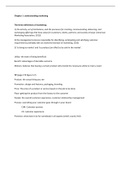Chapter 1: understanding marketing
The three definitions of marketing:
1) the activity, set of institutions, and the processes for creating, communicating, delivering, and
exchanging offerings that have value for customers, clients, partners, and society at large ( American
Marketing Association, 2013)
2) the management process responsible for identifying, anticipating and satisfying customer
requirements profitably (the uk chartered institute of marketing, 2015)
3) ‘to bring to market’ and ‘to produce [an offer] to be sold in the market’.
Utility: the state of being beneficial
Benefit: advantages of desirable outcome
Motives: believes that buying a certain product will provide the necessary utility to meet a need
7P (page 170 figure 5.7):
Product: the actual thing you see
Promotion: design and features, packaging, branding
Price: The price of a product or service based on the job to be done
Place: getting the product from the factory to the customer
People: the overall customer experience, customer relationship management
Process: everything your customer goes through in your brand
CJM: Customer journey
CX: customer experience
Presence: what does it do for somebody in all aspects (smell, sound, feel)
,Chapter 2 understanding buyers
Moment of truth: the moment a person goes from undecided to decided / the moment where the
relationship is in danger
Journey maps: a visual representation of an individuals relationship with an organization, service,
product, or brand over time and across channels. (current experience snot future experiences) figure
2.6 page 57 and figure 2.7 page 58
Journey mapping steps:
1) define critical path stages the persona moves through from beginning to the end of the user
experience
CRITICAL PATH
2) create swim lanes that define goals, actions, tools and emotional state (current goals not
aspirations)
GOAL
/\
ACTION what action has to be taken to reach goals
TOOLS what tools are needed for those actions
3) look for the emotional state, define pain points for each state
EMOTIONAL STATE
PAIN POINTS
, The five steps of consumer-decision-making progress:
1) need recognition
Job-to-be-done (JTBD): what is the job a consumer wants to be done and who sells the
solution to this job. If you buy a drill it’s not because you need a drill, it’s because you need a
hole.
To be able to find the job to be done marketers make a journey map. This way the marketer
might be able to find the job to be done easier.
2) information search
Internal source: the knowledge a person already has
External information sources: outside sources of information. Like sales people and search
engines.
3) evaluation of alternatives: The consumer compares the alternatives using evaluating criteria
4) purchase: A choice is made.
Compensatory decision rule: a person selects the brand with the best score based on
weighing and evaluating a set of criteria.
Non-compensatory decision rule: eliminates options that fail to meet a minimum
requirement on any of the evaluative attributes.
- good performance on an attribute cannot compensate for poor performance on another.
Availability heuristic: choosing an option that’s quick and easy
Representative heuristic: choosing an option that has not been shown to be the most
popular choice
5) post-purchase outcomes: captures the evaluations and behavior following the purchase decision.
Buying behavior: the decision progress and acts of people involved in buying and using products /
influenced by individual characteristics.
The dynamic interaction of affect and cognition behavior, and the environment by which
human beings conduct the exchange aspect of their lives.
Affect=emotion cognition=thinking
B2C (business-to-consumer): marketers study the behavior of end consumers
B2B (business-to-business): marketers study the behavior of organizational buyers
C2C (consumer-to-consumer): peer-to-peer transactions. Examples: etzy and ebay





